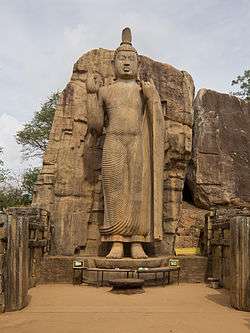Dhatusena of Anuradhapura
| Dhatusena (Dasenkeli) | |
|---|---|
| King of Anuradhapura | |
| Reign | 455–473 A.D |
| Predecessor | Pithiya |
| Successor | Kasyapa I |
| Issue |
Kasyapa I Moggallana I |
| House | House of Moriya |
| Father | Dathanama |
Dhatusena was a king of Sri Lanka who ruled from 455 to 473. He was the first king of the Moriyan dynasty. In some records, he is also identified as Dasenkeli. Dhatusena reunited the country under his rule after twenty six years, defeating the South Indian invaders that were ruling the country at that time. Dhatusena made eighteen irrigation tanks, a large irrigation canal known as Yodha Ela, and the Avukana Buddha statue, a large statue of Gautama Buddha.[1][2][3]
Early life and becoming king
Dhatusena's ancestry is uncertain. The Cūḷavaṃsa, the ancient chronicle of Sri Lanka, tells us that he was of royal lineage whose ancestors had fled the royal capital about three hundred years earlier.[4] The country was invaded in 433 by Tamils apparently of or related to the Pandyan dynasty from South India, known as "the Six Dravidians". They overthrew Mittasena and ruled the Anuradhapura Kingdom for twenty-six years, from 433 to 459. During this time, Sinhalese leaders abandoned Rajarata and fled to the Ruhuna principality in the south of the country. Ruhuna was used as the base for resistance against the invading rulers.
Dhatusena was raised by his uncle, a Buddhist monk named Mahanama. The Pandyan invaders were searching for Dhatusena, and his uncle ordained him as a Buddhist monk to disguise him. Dhatusena later organised a resistance movement against the Tamil invaders and led a rebellion against them. Dhatusena claimed the kingship of the country in 455. By the time Dhatusena started the rebellion, three of the six Pandayn invaders were already dead, and in the battles that occurred during the rebellion, two more were killed. The final battle took place in 459, where the last king, Pithiya, was killed.[5] Having successfully defeated the Pandyan invaders, Dhatusena was crowned as the king of Sri Lanka in 459 A.D, taking Anuradhapura as his capital.
Services as king

Dhatusena built eighteen irrigation tanks in order to develop agriculture in the country.[1] Among these tanks are the Kala Wewa and Balaluwewa, which are interconnected and cover an area of 6,380 acres (2,580 ha).[6]
He also constructed the Yodha Ela, also known as Jayaganga, an irrigation canal carrying water from Kala Wewa to Tissawewa tank in Aunuradhapura. Yoda Ela descends 95 milimeters at each kilometer. This is regarded as a great technological achievement.[3][7]
The Avukana Buddha statue, a 13-metre (43 ft) high statue of Gautama Buddha, is also a creation of Dhatusena.[2]
Death
Dhatusena had two sons, Kasyapa I and Moggallana I. Moggallana was the son of the royal consort and the rightful heir to the throne, while Kasyapa was born to a non-royal concubine. Dhatusena’s daughter was married to his sister’s son and the general of his army, Migara. Following an argument between his daughter and sister, Dhatusena ordered his sister to be killed. In reprisal, Migara encouraged and assisted Kasyapa to overthrow the king and take the throne. Kasyapa eventually rebelled against Dhatusena and overthrew him. Dhatusena was imprisoned and Kasyapa became the king of the country in 473.
Migara led Kasyapa to believe that Dhatusena had hidden treasures of great wealth and persuaded him to find these. When asked to lead Kasyapa to where these treasures were hidden, Dhatusena led him to the Kalavewa and taking water into his hands, claimed that this was the only treasure he had. Enraged at this, Kasyapa had him murdered by entombing him in a wall.[4][8] (an alternate story is that he was buried alive in the bund of the Kalaweva).[1][6]
See also
References
- 1 2 3 "Mahasena and Dhatusena". sri-lanka.50webs.com. Retrieved 2008-10-25.
- 1 2 "Aukana Buddha History". aukanabuddha.info. Retrieved 2008-10-25.
- 1 2 Gamini Jayasinghe (2007-10-15). "A museum for Sigiriya Rock fortress". Daily Mirror. Archived from the original on 2016-03-03. Retrieved 2008-10-25.
- 1 2 Ponnamperuma, Senani (2013). The Story of Sigiriya. Melbourne, Australia: Panique Pty Ltd. pp. 19–22. ISBN 9780987345110.
- ↑ "The latter Anuradhapura Period". Rootsweb. Retrieved 2008-10-25.
- 1 2 "King Dhatusena". sigiriya.gq.nu. Retrieved 2008-10-25.
- ↑ D. G. A. Perera. "Redeploying the armed forces". The Island. Retrieved 2008-10-25.
- ↑ Geiger, Wilhelm (1927). Cūlavaṃsa being the most recent part of the Mahavamsa. London: Milford. p. 40.